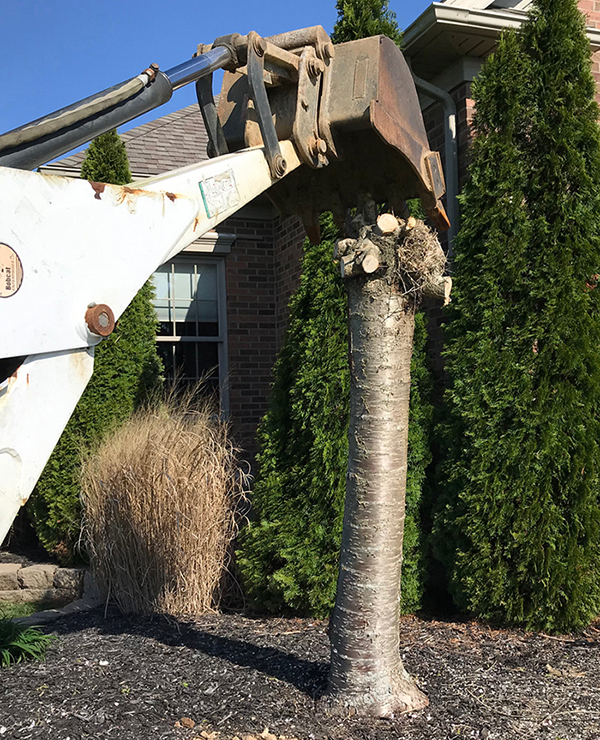
Succeeding with Weeping Cherry Trees
Weeping cherries are one of the most-requested nursery trees, and one of the least understood. They also have a very high failure rate; after dogwoods they are our highest warranty cost item. We like to joke that each weeping cherry is actually two trees in one, so that’s why they have twice as many problems.
What we mean is that each weeping cherry tree has two parts. The roots and trunk (called “rootstock” by nurserymen) are actually a fast-growing sweet wild cherry (usually Mazzard or Mahaleb cherry) like the ones that grow along the roadside, but trained to a single straight trunk. The weeping part or “top-graft” is a hybrid variety; either double-flowering pink Higan cherry (prunus subhirtella) or “Snow Fountains” white weeping cherry (prunus “Snofozam”). The two plants are grafted together at the top of the trunk, which can vary in height between three to five feet above ground. The weeping section provides an umbrella effect if it is pruned regularly, or can grow 25 or 30 feet tall if not cut back.
It is common for sprouts or “suckers” to grow on the trunk or rootstock. If these are allowed to grow they will shoot straight up and take over the tree, ruining the weeping effect. There is a graft scar at the top of the trunk, just below the weeping branches. Anything that sprouts below the graft scar is wild cherry, not weeping cherry, and must be removed. This can be done at any time of year, the sooner the better.
People often ask us for “dwarf” weeping cherry trees. There is actually no such thing. Any weeping cherry tree will eventually grow to thirty feet tall and twenty feet wide if not constantly pruned back. The small weeping cherry trees you see in landscapes are probably still young; once they grow too large for the space most people remove them and start over. Clipping the tree each season can limit its size. If you cut off any shoots pointing upwards, the weeping branches will form a thick canopy.
Young weeping cherry trees are typically top-heavy and need staking for the first year or two to keep them straight. We’ve seen many people try to prop them up by heaping dirt around the base or planting them deeper, but this will kill the tree sooner or later (most likely sooner). Planting any tree deeper than it was growing in the pot or root ball smothers it and kills it. To keep the top-heavy young tree from toppling you must stake it securely for at least a year after planting.
Over-watering is a frequent mistake with weeping cherry trees. Cherry rootstocks are actually very rugged and will tolerate dryness, but are very sensitive to excessive wetness and will drown if over-watered. A deep-root soaking (five gallons or so) once a week is usually enough to maintain newly planted weeping cherry trees. Once the trees are established they should not need watering at all.
Japanese beetles and tent caterpillars love cherry trees, weeping cherries included. Spraying in May and June with BT or fruit tree spray can prevent this problem. Another fix is applying Milky Spore under cherry trees, which will control Japanese beetle grubs quite well over a long period.
People often ask whether the weeping branches should be trimmed off before they touch the ground. Our answer is no, unless you like the “bowl around the head haircut” appearance. Once the branches touch the ground they stop growing, so you get the effect of a gorgeous fountain by not trimming them off. Anywhere you trim, weeping cherries will fork. To get the best effect you should trim within a foot or two of the top graft. This will create more shoots and lead to a thicker appearance. The best time to trim weeping cherry trees is just after they bloom in early spring. Trimming at other times of year will remove the next year’s flower buds, so you won’t get bloom the following year.
Remember that a mature weeping cherry can spread 25 feet wide, so planting it close to buildings and pavement is a mistake. This is not the cute little tree you want at the corner of your house. The photo shows how this will end. You have been warned.
Steve Boehme is a landscape designer/installer specializing in landscape “makeovers”. “Let’s Grow” is published weekly; column archives are online at www.goodseedfarm.com. For more information call GoodSeed Farm Landscapes at (937) 587-7021

